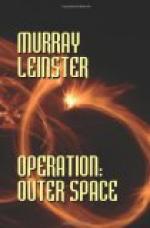“You can wait here in the jeep, Babs—”
But she was already climbing into a suit very much oversized for her, with the look of high excitement that Cochrane had forgotten anybody could wear.
They got out of a tiny airlock that held just one person at a time. They started for the laboratory. And suddenly Cochrane saw Babs staring upward through the dark, almost-opaque glass that a space-suit-helmet needs in the moon’s daytime if its occupant isn’t to be fried by sunlight. Cochrane automatically glanced up too.
He saw Earth. It hung almost in mid-sky. It was huge. It was gigantic. It was colossal. It was four times the diameter of the moon as seen from Earth, and it covered sixteen times as much of the sky. Its continents were plain to see, and its seas, and the ice-caps at its poles gleamed whitely, and over all of it there was a faintly bluish haze which was like a glamour; a fey and eerie veiling which made Earth a sight to draw at one’s heart-strings.
Behind it and all about it there was the background of space, so thickly jeweled with stars that there seemed no room for another tiny gem.
Cochrane looked. He said nothing. Holden stumbled on to the airlock. He remembered to hold the door open for Babs.
And then there was the interior of the laboratory. It was not wholly familiar even to Cochrane, who had used sets on the Dikkipatti Hour of most of the locations in which human dramas can unfold. This was a physics laboratory, pure and simple. The air smelled of ozone and spilled acid and oil and food and tobacco-smoke and other items. West and Jamison were already here, their space-suits removed. They sat before beer at a table with innumerable diagrams scattered about. There was a deep-browed man rather impatiently turning to face his new visitors.
Holden clumsily unfastened the face-plate of his helmet and gloomily explained his mission. He introduced Cochrane and Babs, verifying in the process that the dark man was the Jones he had come to see. A physics laboratory high in the fastnesses of the Lunar Apennines is an odd place for a psychiatrist to introduce himself on professional business. But Holden only explained unhappily that Dabney had sent them to learn about his discovery and arrange for a public-relations job to make it known.
Cochrane saw Jones’ expression flicker sarcastically just once during Holden’s explanation. Otherwise he was poker-faced.
“I was explaining the discovery to these two,” he observed.
“Shoot it,” said Cochrane to West. It was reasonable to ask West for an explanation, because he would translate everything into televisable terms.
West said briskly—exactly as if before a television camera—that Mr. Dabney had started from the well-known fact that the properties of space are modified by energy fields. Magnetic and gravitational and electrostatic fields rotate polarized light or bend light or do this or that as the case may be. But all previous modifications of the constants of space had been in essentially spherical fields. All previous fields had extended in all directions, increasing in intensity as the square of the distance ...




